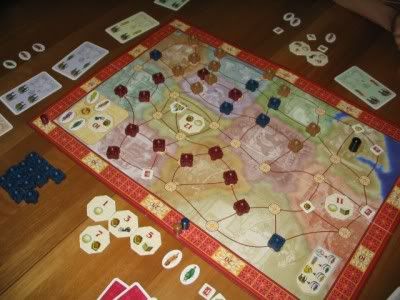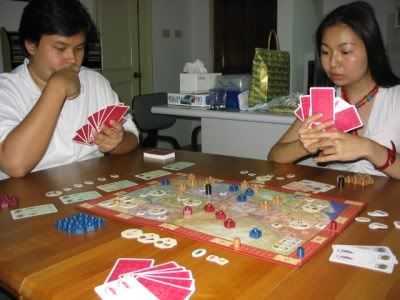Taj Mahal is the second Reiner Knizia title in the alea big box line behind the classic auction game RA. It won the DeutscheSpielerPreis (DSP) award in 2000, the big ticket award for German strategy games, and it was a deserving winner in a very tough field that included the Kramer/Ulrich masterpiece The Princes of Florence.
As you might expect from alea, the game looks great. Northwestern India is represented on a double-folded linen-finished map which is one of the nicest-looking maps in a German game. Players have little plastic palaces, molded in classical Indian design following the Taj Mahal, to place onto the map. The cards are plastic coated and are sturdy enough to withstand a lot of handling (though I won’t quibble with anyone who wants to sleeve them – this is an out of print game after all). The province tiles and other counters are nice and thick. All in all, it’s another exceptional job from graphic designer Franz Vohwinkel.

Taj Mahal is an exceptionally thematic game. The areas of influence that the players are trying to seize control of are important elements of the Indian political environment at the time. The network of power represented by the palaces on the map gives an excellent representation of political networks that are established across a great geographical expanse. When players bid influence, it feels like a titanic struggle. True to form, in each struggle, there is one winner and a bunch of losers. Fantastic.
This game is currently out of print. However, given the deluge of reprints of Reiner Knizia’s Greatest Hits in 2004 and 2005, I would think that it’s a matter of time before we see Taj Mahal again. One can only hope that it reappears in its original form.
The Game
Taj Mahal is a game that combines bidding with tile (or in this case, palace) placement on the Indian map.
The heart of the game is its bidding engine. Players have hands of cards. Each card is one of five colors, including white. Each card also depicts one or two symbols, with each symbol representing one of the forces that the players are vying for.
The players visit each Indian province, one province at a time. In each visit, a tile representing the forces of that province in each of the six areas of influence is up for grabs. Players bid for these tiles by playing cards.
On his turn a player may play one or two cards. If he plays two cards, one must be white (white cards cannot be played alone). Once he plays a card, the player is committed to that color of card and may only play cards of that color in that visit. His bid is the symbols on the cards he played. The bid for each symbol is considered separately. So, if a player plays two cards, one yellow and one white, the yellow card depicting a monk (religious) and a princess (social), and the white card depicting two elephants (economic), he has entered a bid for three different tiles with that single play.
Each player gets to play cards or pass on his turn. When a player passed, he is considered to have “withdrawn” from the visit. When a player withdraws, his bid is evaluated. If his bid in any of the six areas of influence is greater than that of any other player still in the bid, then he wins the tile representing that area of influence. A player can win all the tiles he bid for, none of them, or anything in between.
For each area of influence (excepting economic) that he wins in a province, a player gets to place a palace on a point in the province on the Indian map. The map point may have a counter, which the player claims if he places a palace there. Otherwise, players endeavor to build a network of palaces representing the latticework of their political power in the subcontinent. The larger and more continuous a network, the greater power it brings.
Seizing economic influence in a province entitles the player to the province tile itself, and all the goods produced by the province. The greater the number of each of four different goods controlled by a player, the closer he is to a monopoly, so the greater the power granted.
Once a player seizes two identical influence tiles, he is entitled to control of a special white card (there are four of these cards). These special white cards are powerful, both for their reusability (they can be played once per visit) and for their effect (watch out for the Princess card, which is the subject of many power struggles – don’t you love the theme?).
Finally, after he withdraws, a player is entitled to choose two cards from an open display of replacement cards, which number one less than the number of players times two. Thus, the first player to withdraw gets a full choice of cards, and the last player to withdraw not only gets no choice, he only gets one card. If a player withdraws from a visit without playing a single card, he gets a bonus (face down) card from the deck. The only other way to get more cards is by snagging a “draw a card” counter from a palace point on the map.
Players accumulate influence points from their palace power network, their control over goods, any direct influence points granted by map counters, and the insidious Princess card. The player with the most influence at the end of 12 visits wins the game.
Strategy
As you may have noticed from the game description, the province bid is an all or nothing affair – either you win a particular influence tile or you don’t. This is one of the aspects of the game that frustrates many players. It is quite possible to bid a several cards and end up with nothing. Considering that cards are in very short supply, an ill-considered extended pissing contest between two players is bound to end in BOTH players being crippled for the next few visits, if not for the rest of the game. Coming to terms with the bidding engine is the greatest hurdle that players face. Once this is achieved, Taj Mahal comes into its own as an exceptional many-layered strategy game that plays quickly and places players in a tense grip through its entire length.

Province tiles are randomly assigned to the 12 provinces on the map each game, giving the players a new look every game. It is important to have an initial idea of which provinces a player would like to win at the outset, either for the goods granted by the economic tile or for the networking position, but not to set that desire in stone. This is a game of alternate plans and making do with what you can get. The train wreck that can result in going head-on against a rival is enough incentive to be flexible. Don’t take each bid personally, and know when to sidestep a symbol someone else wants desperately. Each bid you make encompasses more than one symbol, after all. Sometimes, getting out early with one symbol and placing your palace first is the most prudent thing you can do. You can adjust your overall plan for that result.
Another key decision to be made each visit is whether or not to sit the whole visit out and snag a precious extra card (and get an early choice from the cards laid out). You get nothing from that visit, but you get an extra card and spend none; your opponents will spend one or two cards at the very least, giving you an upper hand in subsequent battles.
Know when to fight, and when to withdraw. It’s the key to doing well in Taj Mahal.
Reviewer’s Tilt
I purchased Taj Mahal for $60 blindly from a local store that inexplicably still had a copy on its shelves in early 2004. alea and Reiner Knizia were enough to convince me. I have to admit that I didn’t get the game in the first few plays, and lost every time by a wide, wide margin. The light started to go on after I read initially incomprehensible comments from Thi Nguyen in his Geeklist preaching flexibility in strategy (which I initially read to be “play the game purely tactically, which resulted in a few more train wrecks). I considered playing Taj similarly to the way I play Euphrat & Tigris – have a general strategy in mind, but be flexible to adapt the strategy when opportunities appear or stiff resistance to an original goal manifests. That worked, and I finally began doing much better, finally winning a few times since.
I now consider Taj Mahal to be Knizia’s greatest work behind Euphrat & Tigris. Like E&T, it combines a limited dash of randomness with a combination of flexible strategy and creative tactics. The multiple roads to victory allow players to come up with Plan B, Plan C and Plan D should Plan A be shot down. The bidding is a contest of wills, and it’s very unforgiving due to the very limited nature of the resources available. If you run out of cards, you’re dead in the water for several visits. Don’t let it happen. The intricate scoring of Taj Mahal can also turn off players if the bidding engine doesn’t. It’s not intuitive, but it’s not difficult to get used to after a couple of plays. If you like German strategy games, this kind of scoring shouldn’t be a problem.
Taj Mahal is best experienced with the magic number of four players. In this mode, the roads to victory are well-balanced, and the tension is ever-present. With three, the palace network becomes easier to construct, and there is less tension as there are only three competing for the same number of prizes. Taj Mahal with five is a brutal, exhausting affair that’s not for the faint of heart. It’s well worth experiencing Taj in all three forms, as they each provide a different look at the game.
We should all hope that Taj Mahal gets a reprint at some point in the future. It’s a game that fans of Knizia’s work should experience, if only because it’s fairly unique compared to his other games.
No comments:
Post a Comment